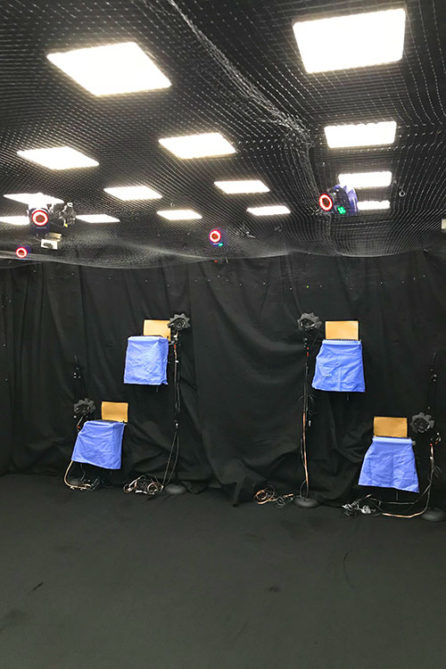Bat Brains Offer A Glimpse into How We Navigate Through the World
NewsThe Problem: Human spatial navigation abilities are incredibly complex, and can go awry in diseases like Alzheimer’s. We know that the brain has specialized ‘place cells’ in the hippocampus to track where we are at certain points in time. Because bats navigate 3D space with speed and precision, they provide a unique opportunity to understand how the brain integrates where we are with where we are going and where we’ve been.
The Study: By studying the activity of place cells in bats, scientists found that these cells represent not just the bat’s current position, but an entire trajectory of motion — effectively integrating memory of past locations with planning future navigation. The study, led by NYSCF – Robertson Neuroscience Investigator Alumnus Michael Yartsev, PhD, of the University of California, Berkeley appears in Science.
Why It Matters: The ability to focus on where we will be in the near future may be a key characteristic of the mammalian brain’s built-in navigation system. This insight may also help scientists better understand navigational impairment in diseases like Alzheimer’s, pointing to new targets for treatment development.
When riding your bike along a busy street, it’s important to focus on the road ahead. Following traffic signals and avoiding collisions with cars or nearby pedestrians is just as important for staying safe than knowing your current position.
How do our brains effectively navigate the road ahead of us? Dr. Yartsev’s team turned to the hippocampus – the primary learning and memory region of the brain – to see how neuronal activity corresponds to our position as we move through the world.
“We wanted to find out: does neural activity at the present moment do a better job at representing a past or future position than it does the actual present position?” said lead author Nicholas Dotson, PhD, in a press release.
Place Cells: The GPS System of The Brain
Place cells are neurons within the hippocampus that process spatial information. These cells activate in different positions in the brain as an animal navigates new environments, and this new information creates an internal map of the area to be stored in memory.
“If you had access to neural activity in my hippocampus while I walked around a room, you’d be able to decode where I was in the room based on this neural activity,” explained Dr. Dotson.
“Because the hippocampus is involved in navigation, there have been several studies looking at coding in this brain region and asking: How does neural activity represent things that are going to happen in the future or that have happened in the past? And can this brain region exhibit activity that doesn’t represent where we are right now, but actually represents a position that is far away?” said Dr. Yartsev.
Previous research exploring this question has been inconclusive, largely because these studies were conducted in slow-moving animals like rats. Thanks to the high flight speed of Egyptian fruit bats, the UC Berkeley research team was able to observe neural activity coinciding with substantial changes in position over time.
“[Bats] fly at speeds of about 30 to 50 kilometers per hour in the laboratory, which is a huge advantage, because in the same fraction of a second, a rat might move a few centimeters, while a bat would move a few meters,” said Dr. Yartsev.
A Glimpse Inside the Brains of Fast-Flying Bats

Dr. Yartsev’s team created custom-built rooms outfitted with cameras to track the bats’ complete flight path and used wireless neural recording devices to monitor their brain activity as they flew around the testing area.
First, the researchers encouraged the bats to explore the entire 3D space of the test room. Then, the team added automatic feeders to the room, enticing the bats to fly from end-to-end.
When comparing neuron activity to the physical location of the bats during flight, the scientists found that this activity had a much stronger correlation to future spatial positions than the current position of the bats. In fact, activity in bats’ place cells suggest they can project a path up to a full second into the future.
“Our findings suggest that as the bats are flying, they’re representing in their mind not just where they are, but where they are along the path,” noted Dr. Dotson.
Implications for Human Navigation and Diseases like Alzheimer’s
Humans and many other species of animals beyond bats also have place cells. This study provides groundwork to define how place cells are used by humans to navigate their surroundings.
“Now that we know that there is some neural representation of future position in bats, we can go and ask: What are the shared components between different animals? And in what ways, and to what extent, do humans exhibit this ability?” remarked Dr. Yartsev.
The findings of this study are also important for understanding major diseases like Alzheimer’s, which severely affects the hippocampus. Alzheimer’s patients often experience an inability to sense their location and navigate throughout the world. Understanding the brain mechanisms behind navigation could shed new light on how exactly navigation is impaired — and how it could be restored — in Alzheimer’s and similar diseases.
Journal article:
Nonlocal spatiotemporal representation in the hippocampus of freely flying bats
Nicholas M. Dotson, Michael M. Yartsev. 2021. Science. DOI: 10.1126/science.abg1278
Cover image credit: Kim Taylor/Warren Photographic